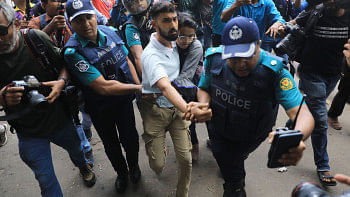Remains of Gaur

Daroshbari Madrasa – hearkening back to the 14th century (left); Daroshbari Mosque, a 14th century structure in Chapainawabganj, decaying through relentless neglect (right) Photo: STAR
Gaur, the capital of Sultanate Bengal is about 35 kms away from Chapainawabganj town. Remnants of the ancient city are scattered within five square kms area. However, the Department of Archaeology has not taken any initiative to preserve the site.
It's the same old story: the Department of Archaeology does not have the funds or manpower necessary to conserve and carry out necessary restorations of the edifices that are gradually wearing away. These structures built between 1494 and 1519 AD include Sona Masjid (mosque), Tahkhana, Kotwali Darwaza (main gate to the ancient capital) and many more. There are a few others mosques in the area and some are decked with exquisite terracotta plaques, though most have lost their gleaming glory.
According to a Department of Archaeology official, there are only three permanent staff and five guards to look after the sites.
The last time the department carried out renovation on some of the mosques and other structures was in 2004.
According to locals, the passage to Dhanaichawk Masjid is now occupied by some influential individuals. A house now blocks the way to Tahakhana.
The Department of Archaeology has repeatedly urged the local administration to remove the illegally placed houses and structures blocking the ways to the mosques, but in vain, says the official.
Darosbari Masjid is famous for its artistic terracotta designs. The mosque is around 99 ft high and 34 ft wide. The old mosque at Omarpur village is now on the verge of ruination after years of negligence. Deep cracks have developed on the walls of the 15th century structure; weeds now cover most of its exterior. Most of the terracotta tiles have eroded. Others have been stolen.
Others make good use of the mosque as a resting place for cattle, as its abandoned.
Dr. Mazharul Islam, a local historian and associate professor at the Chapainawabganj Govt. College said that, one Elahi Bakhsh discovered a mosque in the nearby jungle where he found a stone inscription (11ftx2 ft), which was later taken to the Calcutta Museum in 1876. According to the inscription, the mosque was built during the reign of Sultan Shamsuddin Yousuf Shah in 1479.
Dr. Islam and other locals urge the government to take immediate steps for the preservation of these archaeological treasures.
Badrul Alam, field officer, Department of Archaeology, Rajshahi Division, said, "We have sent several letters to the concerned ministry, requesting for appointment of guards to the sites. We have also requested the concerned authorities to link the sites with roads but no initiative has been taken yet.
The department claims that if the Deputy Commissioner of Chapainawabganj takes active interest in preserving and protecting these sites, these edifices from the Sultanate period have a shot at existence.
When contacted, the Deputy Commissioner of Chapai-nawabganj, Sirajul Haque Khan said that if the roads to these sites are occupied and blocked, he would take necessary steps to be vacate them.

 For all latest news, follow The Daily Star's Google News channel.
For all latest news, follow The Daily Star's Google News channel. 



Comments